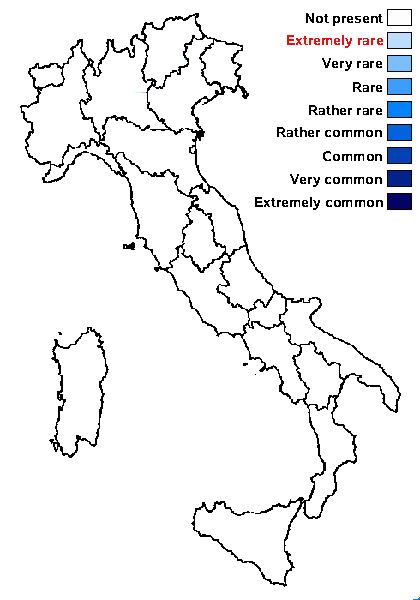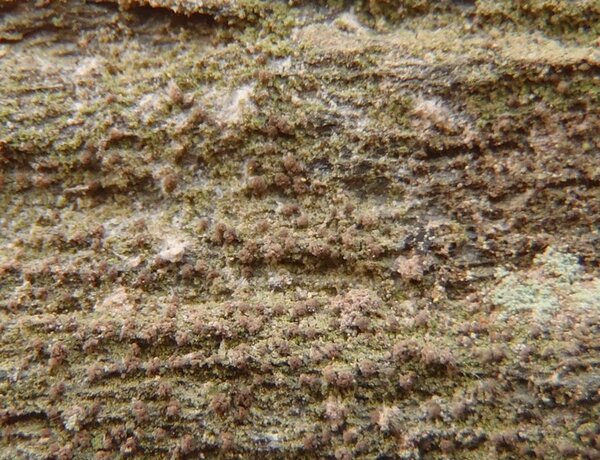Micarea myriocarpa V. Wirth & Vězda ex Coppins
Bull. Br. Mus. nat. Hist., Bot., 11, 2: 161, 1983.
Synonyms:
Distribution:
Description: Thallus crustose, thinly episubstratic, farinose-granular, whitish-green or green, effuse, continuous, or sometimes thicker and cracked. Apothecia 0.1-0.15 μm across, but mostly tuberculate and then to 0.25 μm across, hemispherical, constricted at base, pale brown to blackish-brown or grey-black, without a proper margin. Proper exciple not developed; epithecium brownish; hymenium 25-35 μm high, colourless to dilute brown or partly olive-brown, K- or K+ intensifying (especially when an olive-green pigment is present), usually with darker-coloured vertical streaks; paraphyses rather sparse, of two types: most of them colourless, 0.5-1 μm thick, often branched, some of them 2-3 μm thick, unbranched, usually arranged in brown fascicles; hypothecium reddish- or orange-brown, 35-70 μm high. Asci 8-spored, clavate to cylindrical-clavate, with an unstained wall and a K/I+ blue outer layer and apical dome, the latter with a cylindrical axial mass, 21-25 x 5-7 μm. Ascospores (0-)1-septate, hyaline, narrowly ellipsoid, ovoid or oblong, straight or some of them slightly curved, (5-)6-8(-9) x 1.3-1(-2.5) μm. Pycnidia usually numerous, pale brown to black-brown, sometimes with a very thin, whitish-grey tomentum, globose, often with white blobs of conidia, 25-30 μm wide, 40-50(-60) μm tall, the walls brown and in upper part mostly olive, K± intensifying or brown only at the base. Conidia short-bacilliform, 2.5-3.5(-3.8) x (0.8-)1-1.5 μm. Photobiont not micareoid, the cells subglobose to ellipsoid, some of them resembling Stichococcus , (3-)4-7 x 3-5 μm. Spot tests: thallus K-, C-, KC-, P-, UV-. Chemistry: thallus without lichen substances,
Note: on different kinds of siliceous rocks (granite, gneiss, melaphyre, schist, sandstone), mainly at the base of shaded boulders or vertical faces shielded from direct rain, mostly within forests; widespread in Central, Western and Northern Europe and also known from Turkey (Czarnota 2009). To be looked for in Italy.
Growth form: Crustose
Substrata: rocks
Photobiont: green algae other than Trentepohlia
Reproductive strategy: mainly sexual
In underhangs rarely wetted by rain

Predictive model
Growth form: Crustose
Substrata: rocks
Photobiont: green algae other than Trentepohlia
Reproductive strategy: mainly sexual
In underhangs rarely wetted by rain

Predictive model




